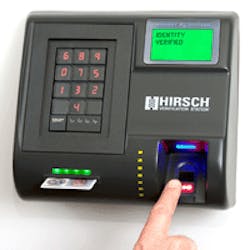SCM Microsystems and Hirsch Electronics to merge
Hirsch Electronics Corporation, a California-based company providing physical access control technologies and solutions, and SCM Microsystems, a German firm specializing in logical/network access control readers and solutions, are to merge. The companies announced today that they have entered into a merger agreement, and the expected result is a converged security solutions company ready to provide enterprise-level access control -- whether that at the door or at the network level.
The financial arrangement of the acquisition is such that Hirsch's holders will receive both cash and common stock in SCM as well as warrants to purchase SCM's common stock based on the price of the SCM stock at the time of the merger's closing. The merger has already been approved by both Hirsch's and SCM's boards of directors and now awaits approval by both company's stockholders. The process of merging these companies still involves an SEC filing and approval, but is expected to occur sometime in the first half of 2009.
The merged company will be known as SCM Microsystems, although SCM and Hirsch's products will both be sold under their own brand names.
The companies say the merger creates a company with a full set of solutions to tie in physical building access control with network access control across an enterprise.
"The synergies in the companies' product lines and the opportunities for new, highly integrated security products are tremendous," said Hirsch President Larry Midland, who is expected to join the board of directors of SCM Microsystems and will become an executive officer of the combined company. "There is virtually no overlap in the companies' current lines, yet the products and technologies are extraordinarily complementary
According to Felix Marx, CEO of SCM Microsystems, the merger doubles the size of SCM. He added that the merger's potential is built upon the changing needs of customers.
"Customers worldwide are calling for converged solutions for information security and physical access control, and that is creating demand for a broad set of devices from doors to desktops with support for smart cards, biometrics and contactless technologies," Marx said. "By combining our respective product lines and resources we can address the full spectrum of customer needs, making our combined company much more valuable to our customers."
Hirsch's Vice President of Marketing Rob Zivney, said that some of what had brought the company's into partnering over the last few years were technology developments as well as interset and efforts in the government security and identity space. He noted that SCM Microsystems had done a good deal of work for both logical security in the government, and the company had even offered solutions for the Department of Defense. At the same time Hirsch has also been actively working on solutions that tie in the with PIV personal identity verification card project which encompasses the DoD Common Access Card and the HSPD-12/FIPS 201 program. But the synergies, Zivney said, don't end with the government marketplace.
"We also think PIV is going to drive new technology into the commercial sector," said Zivney. "The commercial sector wants a combined card. With their strengths in logical and ours in physical, we think we'll be able to provide a solution for that."
Zivney added that both firms understand that today's solutions are much more than simply bolting on and wiring in hardware.
"We feel like we bring the system together. Not only controllers and servers and readers and software, but our professional services [at Hirsch] has been one of our fastest growing businesses today. We can come in with a goal of interoperability and make these systems talk together so when one thing happens in one part of the organization, it also happens in other parts of the organization which are affected."
Zivney added that both firms seemed to understand that to move their business forward, they would be entering an era where the readers are no longer simply readers, but actually operate like computers which are doing identity and authentication processing at the edge of an access control system.
"SCM has a product called the PACT -- the Physical Access Control Terminal," noted Zivney. "They call it a terminal instead ofa reader, and it makes sense, because it does much more than just read a card."
